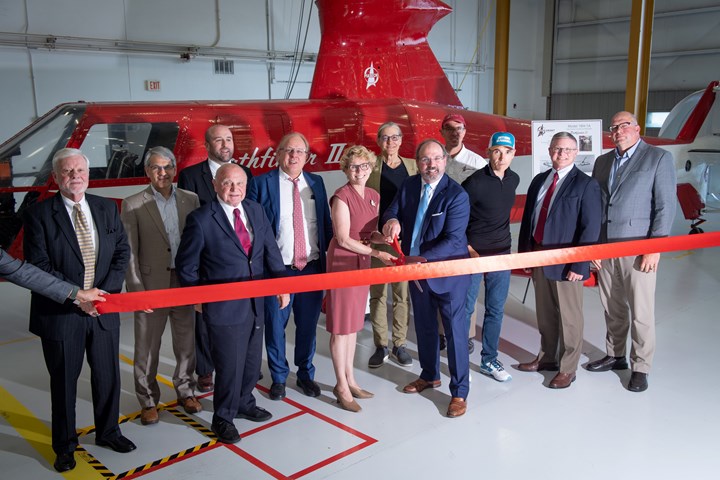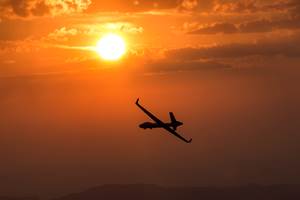Piasecki acquires former Lockheed Sikorsky facility for VTOL development
Former Heliplex facility in Coatesville, Pennsylvania, will be transformed into an R&D center for VTOL and UAS aircraft, including Piasecki’s HAXEL demonstrator and PA-890 which use composites.
From left to right: Mike Stanberry, Mike Hirschberg, Rick Siger, Arthur Kania, Fred Piasecki, Rep. Chrissy Houlahan, Dr. Martine Rothblatt, John Piasecki, Greg Piasecki, Val Miftakhov, Michael Tremlett and Bill Moeller. Photo Credit: Piasecki
Advanced rotorcraft technology company Piasecki Aircraft Corp. (PiAC, Coatesville, Pa., U.S.) has acquired the former Lockheed Martin (Bethesda, Md., U.S.) Sikorsky Heliplex facility in Coatesville, Pennsylvania, which previously served as a production and delivery center for Sikorsky’s S-76 and S-92 helicopters.
The company will transform the 219,000-square-foot state-of-the-art facility into an advanced research and development (R&D) center for next-generation vertical takeoff and landing (VTOL) aircraft, unmanned aerial systems (UAS) and related enabling technologies. Notably, the company’s forthcoming PA-890 zero-emission hydrogen fuel cell rotorcraft, will be built and tested there. The “slowed-rotor winged compound helicopter” concept, as currently envisioned, will have a carbon fiber composite fuselage, according to Electric VTOL News. Moreover, the hydrogen-powered coaxial helicopter demonstrator HAXEL, to be used to perform the company’s first human-carrying, hydrogen-powered helicopter flight test, features “two counter-rotating, two-bladed composite rotors with a diameter of 6.5 meters.” Its cabin and tail are also comprised of carbon fiber-reinforced composite materials.
The Coatsville facility — which includes engineering development, aircraft assembly, paint and finishing facilities, and a well-equipped production flight test and delivery center — will open its doors to employees in the fall and is expected to attract about 400 workers by 2028.
“This world-class facility will serve as a strong foundation for future growth and will enable us to expand our R&D and production capabilities as we deliver transformational vertical lift technologies to the defense and commercial markets,” John Piasecki, CEO of PiAC, says. “We chose to expand our development capabilities in the Delaware Valley because of its deep roots within the helicopter industry, its highly talented workforce, and its robust supplier network.”
This year also marks 80 years of innovation at PiAC in vertical flight, which began in 1943 with the PV-2 helicopter. “Shortly after, PiAC developed the world’s first tandem rotor helicopter — a revolutionary design that has been instrumental in life-saving missions around the globe since WWII — and which lives on in Boeing’s CH-47 Chinook helicopters,” Piasecki continues. “PiAC is building on this legacy with a truly groundbreaking vertical lift technology portfolio, including advanced digital flight control and flight automation technology, hydrogen fuel cell and hybrid propulsion systems, morphing aerostructures and more. We work closely with partners in government, academia and industry to advance these technologies and develop platform and system-level air vehicle integrations as well as conduct flight tests.”
In addition to the PA-890 eVTOL, major PiAC R&D programs currently being executed include the aerial reconfigurable embedded system (ARES), a modular multi-mission tilt duct VTOL vehicle that can be operated unmanned (UAS) or with an optional manned flight module, and the company’s adaptive digital automated pilotage technology (ADAPT), a flight control software package designed to achieve improvements in safety/survivability, performance and affordability for U.S. military and commercial aircraft.
For related news, read “HyPoint, Piasecki Aircraft collaborate to develop, certify eVTOL next-generation hydrogen fuel cells.” The fuel cell system, to be developed for the PA-890, will most likely use composites, per Hypoint’s partnership with GTL for ultralight liquid hydrogen tanks.
Related Content
TenCate Advanced Armour renamed to Integris Composites
With its rebranding, Integris maintains the ability to develop, test and manufacture ballistic armor and survivability solutions while expanding into new markets where composite solutions can be advantageous.
Read MoreFarnborough Airshow 2024 brings together aerospace innovation, collaboration
The week-long international airshow provided a hub for new announcements made by Boom Supersonic, Airbus, Boeing, GKN, GE, ZeroAvia, Eve, Bell, VoltAero, Eve and Lilium. CW has compiled several below.
Read MoreHypersonix receives CMC scramjet manufacturing demonstrator
HTCMC component demonstrates manufacturing of future Spartan scramjet engine required for reusable hypersonic vehicles capable of up to Mach 12 flight.
Read MoreIndustrializing additive manufacturing in the defense/aerospace sector
GA-ASI demonstrates a path forward for the use of additive technologies for composite tooling, flight-qualified parts.
Read MoreRead Next
Leveraging motorsports composites for next-gen rotorcraft
FastCan consortium integrates hollow, solid and cored CFRP into single-cure, single-piece canopy for reduced weight and cost.
Read MoreDeveloping bonded composite repair for ships, offshore units
Bureau Veritas and industry partners issue guidelines and pave the way for certification via StrengthBond Offshore project.
Read MoreAll-recycled, needle-punched nonwoven CFRP slashes carbon footprint of Formula 2 seat
Dallara and Tenowo collaborate to produce a race-ready Formula 2 seat using recycled carbon fiber, reducing CO2 emissions by 97.5% compared to virgin materials.
Read More


























